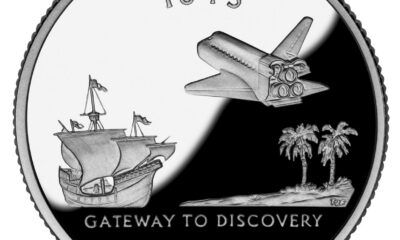Human Interest
Silk Road notes 1: silk

An exhibit, “1001 Inventions” is now showing worldwide, and what appears to be a small section, regarding the Silk Road, is on display at the Cleveland Museum of Natural History. The larger professes to be a revelation of a thousand years of scientific and cultural achievements by the Muslim world, with a nod to the various faiths and cultures that contributed. However, these faiths and cultures were victims of Muslim jihadists, those who followed in the footsteps of Mohammed and invaded the non-Muslim world over 1400 years – beheaded, slaughtered, raped, plundered, and took ownership of the creativity and advancements made by the besieged, converted survivors.
An award-winning film accompanies the global touring exhibition, which touts the best Islamic invention of all –that Muslims were able to appropriate every creative, innovative, ground-breaking device of Islam’s victims and, defying all logic, fraudulently claim each as their own.
The Silk Road exhibit is a betrayal of its name and deception to the visitors, individuals, schoolteachers and students. Consider that some of the visitors are of those cultures whose contributions were formidable,yet were omitted or given scant recognition, thereby denying them the knowledge and sense of pride to be had upon learning that their heritage contributed to the growth of civilization along the early trade routes. This Islamic presentation allowed about 20% to China.
Islam’s growth in both religious adherents and these “achievements” relied on their invasions into foreign lands, enforcing their will under penalty of death, and booty acquired from the invaded and enslaved cultures (the worst, the black African trade, was excluded). The slave trade exists to this day, such as Boko Haram’s kidnapping of hundreds of schoolchildren and selling them into sexual slavery, and the kidnapping and killing of the Yazidi tribe of Iraq (also Diyarbalor, Turkey, Aleppo, Syria, Armenia, Caucasus region and Iran). Therefore, when Islam is said to have “spread” across the land, the euphemism refers to Muslims who warred against the populace and either converted, killed, or took them for trade. Slavery is justified in the Qur’an, and Jews, Christians, Hindus, Buddhists, polytheistic and animist creeds became Islamic and their crafts and ingenuity were absorbed into Islam, ultimately for these empty claims of accomplishment.
Islam is socialism, and socialism is antithetical to creativity. Islam is based on envious hatred of what is noble, the aspirations and outstanding creative individuality in all fields of human endeavor. Muslims are enraged that a small Israel could smash the rocket launchers and their terror tunnels of Gaza. They resent and hate human excellence, yet they take ownership of the ingenuity of others out of envy.
The museum exhibit is just such an example of Muslims’ adopting achievements of others for their own acclaim, because they have produced nothing of value in 1400 years of existence. To this day, they are illiterate warring nations who commit atrocities beyond the Western imagination. For other information, see Silk Road (disambiguation).
Defining the Silk Road
|
Main routes of the Silk Road |
|
|
General information |
|
|
Location: |
Eurasia |
|
Official name: Silk Roads: the Routes Network of Chang’an-Tianshan Corridor |
|
|
Type: |
Cultural |
|
Criteria: |
ii, iii, iv, vi |
|
Designated: |
2014 (38th session) |
|
Reference No. |
|
|
State Parties: |
|
|
Region: |
|
 The Silk Road, or Silk Route, is a series of trade and cultural transmission routes that were central to cultural interaction through regions of the Asian continent connecting the West and East by traders, merchants, pilgrims, monks, soldiers, nomads, and urban dwellers from China to the Mediterranean Sea during various periods of time.
The Silk Road, or Silk Route, is a series of trade and cultural transmission routes that were central to cultural interaction through regions of the Asian continent connecting the West and East by traders, merchants, pilgrims, monks, soldiers, nomads, and urban dwellers from China to the Mediterranean Sea during various periods of time.
Extending 4,000 miles, the Silk Road derives its name from the lucrative trade in Chinese silk carried out along its length, beginning during the Han Dynasty (206 BC – 220 AD). The Central Asian sections of the trade routes were expanded around 114 BC by the Han dynasty, largely through the missions and explorations of Chinese imperial envoy, Zhang Qian. The Chinese took great interest in the safety of their trade products and extended the Great Wall of China to ensure the protection of the trade route.
Trade on the Silk Road was a significant factor in the development of the civilizations of China, the Indian subcontinent, Persia, Europe, and Arabia, as well as into Korea and Japan, opening long-distance, political and economic interactions between the civilizations. Although silk was the major trade item from China, many other goods and various technologies, religions, and philosophies, as well as the bubonic plague (the “Black Death“), also travelled along the Silk Routes. In addition to economic trade, the Silk Road served as a means of carrying out cultural trade among the civilizations along its network.
A vertical screen hangs at the entrance:
HOUSE OF WISDOM
He who travels in the search of knowledge, to him God shows the way of Paradise. (attributed to the Prophet Mohamed)
WHAT WASN’T SAID:
- That Islam provides a martyr’s way to Paradise, which includes destruction, slavery, suicide and genocide, and looting, and
- That Islamic countries lead the world in illiteracy.
FACTS:
- The most prominent reward promised Islamic Martyrs are the 72 Dark-Eyed Virgins in Paradise. A Palestinian religious leader explained that the purpose of authentic Islam is “to fill Muslims with desire for Paradise”– the anticipation and love of death. “He [Muhammad] said (in a Hadith, Islamic tradition): ‘[There is] a palace of pearls in Paradise and in it seventy courts of ruby….And in each court [there are] seventy houses of green emerald stone. In every house, seventy beds. On every bed, seventy mattresses of every color and on every mattress a woman’” (Hadith)
- The writing of the Prophet [Muhammad in this Hadith]…is intended to fill Muslims with desire for Paradise…to be worthy of it, because only three dwell there: Prophets, Righteous and Shahids (Martyrs for Allah).
“[Al-Hayat Al-Jadida, Jan. 2, 2004]
Sahih al-Bukhari HadithHadith 1.35 Narrated by Abu Huraira
The Prophet said, “The person who participates in (Holy battles) in Allah’s cause and nothing compels him to do so except belief in Allah and His Apostles, will be recompensed by Allah either with a reward, or booty (if he survives) or will be admitted to Paradise (f he is killed in the battle as a martyr), Had I not found it difficult for my followers, then I would not remain behind any sariya going for Jihad and I would have loved to be martyred in Allah’s cause and then made alive, and then martyred and then made alive, and then against martyred in His cause.”
http://www.inthenameofallah.org/Shaheed%20OR%20Martyr.html
EXHIBIT SIGN
The main traders during antiquity were the Chinese, Persians, Romans, Armenians, Indians, and Bactrians, and from the 5th to the 8th century the Sogdians. During the coming of age of Islam, Arab traders became prominent.
HISTORIC BACKGROUND:
[ezadsense midpost]
Ancient Chinese guarded the silk production secret for centuries. Ottoman Turks and Persians fought over it; English and French competed to restrict is markets, but every culture was touched by silk. It was found aboard medieval Viking ships sailing out of Constantinople and as kerchiefs from India and bandanas worn by American cowboys. Damask silk of Damascus, Syria, was actually from China. Martha Washington wore a dress of Virginia silk to George’s inauguration, and Native Americans learned silk embroidery to decorate traditional apparel.
WHAT WASN’T SAID:
- The Jews (Persian and Babylonian) pioneered the intercontinental trade and the Silk Road.
- It is likely that these Arab traders are an all-encompassing term to include all the people, religions and cultures that existed in the Middle East, that the Muslims captured and made their own; proper due is not given the individual groups. And, in fact, Arab ethnic groups that inhabited or were adjacent to the Arabian plate included Lebanese, Syrians, Emiratis, Qataris, Saudis, Bahrainis, Kuwaitis, Iraqis, Omanis, Jordanians, Palestinians, Yemenis, Sudanis, and Egyptians. These were not all Arab, in fact;neither were they of the same original religion, so the exhibit is misleading.
FACTS:
- Intercontinental trade was pioneered by Persian Jews who forged the “Silk Route” to the heart of China in the fifth century BCE. Augustus,first Roman emperor, is said to have commissioned “the first travel guide” from Isidore of Charax (a town on the Euphrates River estuary on the Persian gulf). Centuries later, while the Europeans were still deep in the Dark Ages, Persian Rhadanite scholar/travelers pioneered land and sea trade routes to the Far East. “These merchants speak Arabic, Persian, Roman, Frankish, Spanish, and Slavonic,” wrote Ibn Khurdadhih in the ninth century CE, “They travel from East to West and from West to East by land as well as by sea. ” They also spoke Hebrew and Aramaic.
- The “Silk Route“was pioneered by Babylonian Jews in the fifth century BCE. The Kaifeng, China synagogue complex was erected in 1163 to serve a community of three thousand worshipers, and to accommodate Jewish trader-travelers who came across Asia with their caravans. (From Jews in Old China by courtesy of the author, Sidney Shapiro, and of Hippocrene books, publisher.)
EXHIBIT SIGN
The Beginning of Islam
The Islamic religion is based on the teachings of Muhammad, a merchant from the Arabian city of Mecca, who lived from around 570 to 632. Muhammad became the leader of the Arab people in the early 600s, after receiving a series of messages that he accepted as the word of God.
Muhammad recited these revelations to others, and after his death, his followers gathered them into a book that became known as the Koran, or “recitation.” As the new religion of Islam spread, Arabic calligraphy spread with it. This page is the work of the renowned Baghdad calligrapher Ibn al-Bawwab, who made 64 copies of the Koran in all.
WHAT WASN’T SAID:
- This exhibit is designed to be an indoctrinal, rather than an educational,explanation of Muslim activity in this period, representing 80% of the exhibit, and that those who contrived it must have been aware and complicit in what we recognize as civilizational jihad.
- That Judaism, Christianity, Buddhism, Hinduism and other religions would not be represented equally.
- That the visiting, paying viewers were lured under false pretenses and the exhibit itself was not vetted for truth.
FACTS:
- Mohammed became the leader of the Arab people in the early 600s, after dreaming that he received messages from God.
- He beheaded the Jewish men of Mecca; killed or enslaved men, women and children of Mecca and Medina(Christians and idol worshippers), ethnically cleansed the cities and designated them“holy.” Thus he became the leader of those who converted to Islam in order to survive.
- Moslems or Mohammedans do today as they did in the early 600s: behead men and enslave and convert to Islam the surviving women and children
- “Spread” is an oft-used euphemism in today’s revisionist textbooks. The word, although never defined, refers to conquest by force and conversion or death.
EXHIBIT SIGN:
TIMELINE
c. 1070: Persian poet and mathematician, Omar Khayyam, makes advances in algebra and geometry.
c. 1100-1200: Scholars translate scientific works from Arabic into Latin, setting the stage for the European Renaissance. Islamic scholars translated many Greek works into Arabic, including this groundbreaking book on medicinal plants by the Physician Pedianos Dioscorides (c: AD 40-90). The volume shown here was made in the 1240. This page catalogues the herbs mint, basil, thyme, and germander.
WHAT WASN’T SAID:
- That the term “scholars”is used only for Muslims, and presented as an isolated phenomenon, unknown to other cultures.
- That the intent is to usurp the inventions and creativity from other cultures and subtly present them as Islamic.
- In a show of multiculturalism, there were several one-minute slides,questions and answers on a screen. One asked about the music of Matishyahu , “An American singer,” although he identifies himself as an orthodox Jew and sings a combination of Hebrew and reggae. The “correct answer” given on the screen was only reggae.
FACTS:
- Muslims translated Greek works into Arabic, but the exhibit implies that they, not the Greeks, are to be credited with the scientific achievements. Arabs introduced the numeric system, that originated in India, as their own; hence Arabic numerals originated in India.
- Several references were made that China’s accomplishments’ werehinged on obtaining other products from around the world, as though China were unable to achieve success without the aid of Arabs.
(to be continued)
[ezadsense leadout]
Author of “Confronting the Deception,” Tabitha Korol began her political career after 9/11, with letters to the editor and essays, developing a readership and earning two writing awards along the way. Her work appeared on Academia.edu, Christian Action Network, Conservative News and Views, Dr. Rich Swier, iPatriot, Liberty News & Views, LobbyistsforCitizens.com; Published Reporter, Renew America, Ted Belman, The Noisy Room, Trevor Loudon’s New Zeal, Virginia Christian Alliance, WebCommentary, and others.
-

 Civilization4 days ago
Civilization4 days agoDC Pipe Bomb Arrest Raises Questions About Christopher’s Wray’s FBI
-

 Civilization5 days ago
Civilization5 days agoThe Legal Logic Behind U.S. Operations Against Narco-Terrorist Networks
-

 Executive5 days ago
Executive5 days agoNewsom’s ‘National Model’ for Homeless Wracked by Fraud
-

 Executive4 days ago
Executive4 days agoWhen You’re in a Hole, Stop Digging
-

 Education3 days ago
Education3 days agoWaste of the Day: Taxpayers Subsidize Football Coach Severance
-

 Executive2 days ago
Executive2 days agoWaste of the Day: Obamacare Failed Test, Approved Fraudulent Subsidies
-

 Civilization3 days ago
Civilization3 days agoPence Calls on Trump To Fire RFK Jr Over Abortion Drug
-

 Executive4 days ago
Executive4 days agoWaste of the Day: Feds Pay Nonprofits That Sue the Government













Jim Levandowski liked this on Facebook.
[…] Silk Road notes 1: silk […]
[…] To see Part 1, follow this link. […]
[…] Silk Road notes 1: silk […]
[…] Silk Road notes 1: silk […]
[…] Silk Road notes 1: silk […]
[…] Silk […]